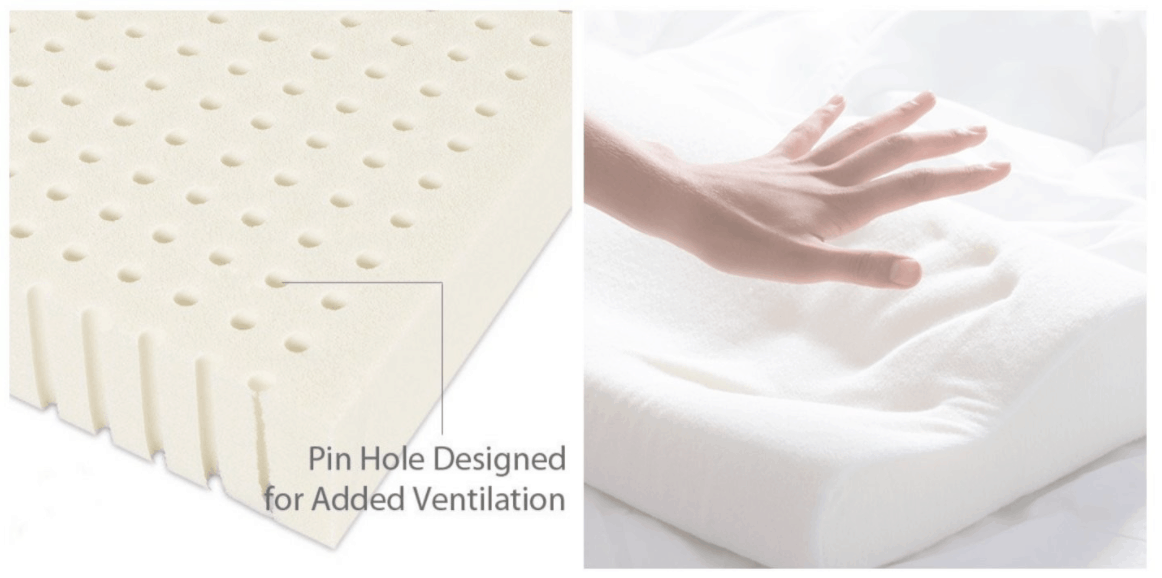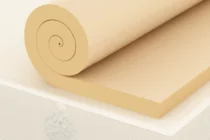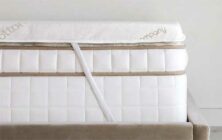The quality of your furniture impacts your physical and mental health. As a matter of fact, the softness and firmness of a mattress are the major factors affecting not only your spinal alignment, but also your overall mood and energy level. If you feel like your mattress is not suitable for your body or is too old to support your back properly, don’t freak out. Just add a mattress topper on top of your old mattress to refresh it! Mattress toppers are also ideal for making new mattresses comfier. Generally, new mattresses are too firm and may require an additional layer of cushioning to provide extra flexibility and better support for your hips, spine, back, and shoulders. Therefore, if you want to improve your sleep quality and overall health, you should probably consider purchasing a mattress topper instead of investing too much money in a brand-new mattress. So, if you’re wondering what the difference is between latex vs. memory foam mattress toppers…
When comparing latex vs. memory foam mattress toppers, both materials are comfortable, durable, provide support, and relieve pain at pressure points. However, latex mattress toppers tend to be more expensive and heavier. Memory foam, on the other hand, tends to be warmer and may have an initial odor when you first set it up.
3 great mattress topper we recommend
Since latex and memory foam mattress toppers are two of the most popular options you can go with, this article will provide some pros and cons you should consider before purchasing a particular topper. The main differences between these two toppers are the materials and characteristics of each. Latex is (typically) a natural material made from the sap of rubber trees. On the other hand, memory foam is a synthetic material consisting of polyurethane and other chemical compounds that increase its viscosity and density.
We’ll discuss more about this in our article.
What is a Mattress Topper and What Is It Used For?
A mattress topper is an additional cushioned layer that can be put on top of a regular mattress to provide better support to an individual’s spine and back.
If you are wondering why you may want to invest your money in a mattress topper vs. buying a mattress, the answer is that mattress toppers are much cheaper compared to mattresses. Here’s our article discussing when you should buy a mattress topper vs. a new mattress.
A mattress topper is used for improving support for your back by making the mattress either softer or firmer. Depending on your personal preferences and needs, a mattress topper with a specific amount of softness or firmness, thickness, and density should be selected. Proper selection of mattress topper material, firmness, and thickness is essential for effective pressure point relief.
Mattress toppers can also be used for making a new mattress more comfortable. Take a look at this scientific article from PLOS, which discusses how mattress toppers drop your body temperature and promote deep sleep.
While a lot of people think that mattress toppers are used for protecting mattresses from wear and tear, we should note that this is not completely true. Of course, using a topper will protect the mattress, but protection is not the main purpose of the topper. If you wish to preserve your mattress and make the most of its life, you are probably looking for a regular mattress protector that will simply cover the mattress and increase its lifespan. A mattress protector can protect your mattress, your mattress topper, and your mattress pad! Here’s a cooling, waterproof mattress protector from Amazon with great ratings.
Another alternative to mattress toppers is a mattress pad, a relatively thin cushioning that can also be put on top of a mattress. Although mattress pads can also make the mattress softer, they are typically used for simply protecting mattresses. They are also great alternatives for thin mattress toppers.
Related articles:
- We’ve written a detailed article about when you need a mattress topper vs. a mattress pad vs. a new mattress.
- Also check out Susy Salcedo’s article on Nectar for detailed information about the differences between a mattress pad and a mattress topper.
- How often should you replace a mattress protector?
- How do you layer a mattress topper, pad, sheets, and protector?
Comparison of Latex vs. Memory Foam Mattress Toppers
As mentioned earlier, latex and memory foam are two of the most popular materials used for not only mattresses and pillows, but also for mattress toppers. Before you make a choice between latex vs. memory foam mattress toppers, it is important to know the differences as well as the pros and cons of each. So, let’s get started!
Pros and Cons of Latex Mattress Toppers
Typically, latex mattress toppers are made of natural latex. Herein lies the biggest advantage. Natural latex is a high-quality material that not only delivers superb comfort but also helps with pressure point relief. How this works is that latex improves spine alignment by allowing some of your body parts to sink into the topper. Generally, heavier parts sink into the material, while lighter ones are kept supported by the topper.
Pros of latex mattress toppers include its superb comfort, the ability to help with pain relief, resistance to fungus and dust, self-ventilation, and durability. Along with that, natural latex makes mattress toppers allergen-free and reduces the risks of electromagnetic radiation due to its zero-metal ingredients. The only cons of latex mattress toppers are that they are pretty expensive and are too heavy.
Latex mattress toppers are resistant to mold and dust particles so it is naturally allergen free. Also, latex is a natural product, meaning that three is no need to add any chemicals to protect the topper from fungus or dust.
Furthermore, latex mattress toppers are extremely durable and provide superb self-ventilation. For extra air circulation, toppers usually have pin holes that allow the material to breathe at all times. Increased airflow not only makes the topper cooler during hot summer nights, but also significantly improves hygiene because you don’t sweat as much. Here’s a 2 inch thick latex topper with pin holes for additional ventilation (from amazon).
The main reason why you may not want to purchase a latex mattress topper is that latex is more expensive than other materials. Memory foam tends to be a cheaper alternative.
Additionally, latex mattress toppers tend to be more firm and heavy. Therefore, if you are looking for a soft and lightweight mattress topper for your bed, latex may not be for you.
Lastly, latex mattress toppers may not be available in local furniture stores, meaning you may have to purchase them through online platforms. In this case, you cannot really feel the material until the package is delivered to you. Lack of availability can be a problem, but if you purchase a highly-rated product through any online store, there will probably not be any quality issues.
Other than that, latex is among the top materials for different furniture pieces, including mattresses, pillows, mattress pads, and mattress toppers.
Related articles:
- If your mattress topper is still hot, it might be an issue with the mattress protector. We discuss how to replace a mattress protector that’s hot or uncomfortable
- For further pain relief, consider a magnetic mattress pad. We’ve discussed the benefits of magnetic mattress pads in our article.
- To learn more about some other pros of latex products, check out a comprehensive article on European Bedding.
Pros and Cons of Memory Foam Mattress Toppers
Memory foam is a synthetic material, the firmness of which can be controlled by changing the concentration of different compounds in the initial mixture. While the main component of memory foam is polyurethane, there are additional chemicals used for making it denser and more viscous. Scarfato et al. studied the effects of weathering on memory foam mattress toppers and described the structural and mechanical properties of memory foam mattress toppers in this scientific article from the Journal of Composites.
Pros of memory foam mattress toppers include affordability, excellent back support, ability to promote pressure point relief, durability, and low maintenance requirements. Since memory foam mattress toppers are synthetic, they commonly have an initial odor and can also be too hot to sleep on during hot summer days. If your mattress topper is not breathable enough, you may get too hot and sweaty throughout the night.
Memory foam is a durable material (which can last for 10-15 years) that requires low maintenance. Additionally, memory foam mattress toppers are relatively inexpensive compared to other types of toppers and it still provides the support that your body needs while you are sleeping. The following research article from Biomedical Engineering Online explains how a memory foam mattress can help with spinal alignment.
Unfortunately, there are some cons you should also consider when shopping for a suitable memory foam mattress topper. First of all, memory foam mattress toppers have polyurethane odor during the first couple of days. Although the smell should dissipate in about 48 hours if placed in a well-ventilated area, this odor can be annoying. In this linked article we discuss how long memory foam takes to expand.
The fact is that memory foam is manufactured by mixing different chemicals, including toxic compounds such as formaldehyde, naphthalene, benzene, and sometimes even isocyanates. We’ve discussed mattress fire retardants and their effects in this linked article.
Also, memory foam mattress toppers may trap heat and make the bed stuffy during hot and humid days. The lack of airflow can promote sweat accumulation and make the topper dirty. The formation and growth of mold and dust particles may lead to severe allergies and additional health issues.
Keep in mind that high-quality memory foam mattress toppers are excellent alternatives to other types of toppers. The issues discussed above are especially true for low-quality versions.
For further information on memory foam pros and cons, check out the article on Ecosa.
Here’s a summary of the pros and cons of latex vs. memory foam mattress toppers:
| Pros of Memory Foam Mattress Toppers | Cons of Memory Foam Mattress Toppers |
| Inexpensive | Synthetic |
| Requires low maintenance | May contain toxic chemicals |
| Durable | Initial odor can be strong and annoying |
| Does not transmit movement | Low quality memory foam as very little self-ventilation |
| Provides excellent support to spine and back | Can get too hot during summer |
| Can help with pressure point relief | Mold and dust can accumulate and lead to allergies |
| Lightweight | May not feel soft and supportive when its cold, since it requires body heat to support specific parts of your body |
At just $100, this memory foam mattress topper from Lucid, is among our favorites on Amazon. It’s 3 inches thick and provides a soft, plush feel to the mattress. Lucid also provides a 3 year warranty which is how they attest to the quality and durability.
| Pros of Latex Mattress Toppers | Cons of Latex Mattress Toppers |
| Natural | Expensive |
| No toxic chemicals present | Can be too firm initially |
| No initial odor | Relatively heavy compared to other types of toppers |
| Environmentally friendly | May not be available in local stores |
| Self-ventilating and breathable | You may have to order a latex mattress topper online |
| Resistant to mold and dust | |
| Allergen-free | |
| Comfortable | |
| Durable | |
| Ideal for pressure point relief and can help with pain | |
| Motion is not transferred | |
| Responds to your body instantly | |
| Does not require body heat to be activated |
We recommend you check out this latex foam mattress topper from Amazon. It’s 3 inches thick, which gives it just the right thickness to change the feeling of your bed (thinner mattress toppers are less effective at changing surface properties of your mattress. Here’s a guide to choosing mattress topper size and thickness). It also has pinholes for added ventilation and really positive reviews on Amazon.
Can You Use a Latex Mattress Topper on a Memory Foam Mattress? What Are the Advantages and Disadvantages?
You can use a latex mattress topper on a memory foam mattress. This will make your mattress firmer and cooler. However, latex mattress toppers tend to cost more than memory foam mattress toppers.
As we have discussed earlier, latex is a natural material that has many more benefits than memory foam products. Therefore, sleeping on top of a latex topper would be better than on a memory foam mattress.
The only disadvantage of latex mattress toppers is that they are expensive. However, if you have no problems with that, you are free to make your bed comfier and healthier by layering a latex topper onto the memory foam mattress.
Related articles:
Can You Use a Memory Foam Topper on a Latex Foam Mattress? What Are the Advantages and Disadvantages?
You can use a memory foam mattress topper on a latex foam mattress. This is a cheap way to maker your latex mattress last longer. However, memory foam mattress toppers are warmer and softer than their latex counterparts.
If you have a functional latex mattress, and you need some extra cushioning and support, using a memory foam topper may not be the right choice. Consider using natural materials like wool, down, or latex for your mattress topper instead of memory foam. Using memory foam may negate some of the positives of your latex mattress such as its ventilation and firmness.
On the other hand, the natural materials mentioned above will preserve the breathability of the latex mattress.
A Summary of Other Mattress Topper Materials and Their Advantages
While latex and memory foam products are among the best-selling options, there are a couple of other mattress topper alternatives. Some basic information and the pros and cons of each mattress topper material will be provided below.
Wool Mattress Toppers
Wool mattress toppers are natural alternatives to latex. They are sustainable, natural, hypoallergenic and self-ventilating. Wool mattress toppers also provide great support and restful sleep. Since wool promotes airflow, the topper remains cool in the summer and preserves warmth in the winter.
The disadvantages of wool mattress toppers are the high cost and the fact that, since they are sourced from animals, they are not ‘cruelty-free’. Therefore, if you are against using animal-based products, avoid purchasing wool mattress toppers and go with other cruelty-free materials.
Consider a great wool mattress topper like this one. It’s relatively affordable and has solid ratings by users.
Down/Feather Mattress Toppers
Down or feather mattress toppers are yet another natural product that offers extra softness and luxurious comfort. Natural materials allow the underlying mattress to breathe and remain cool even during hot summer days. On the contrary, feather toppers can also provide extra warmth that is beneficial in the winter. Hence, down and features are thermo-regulating.
You’ll need to test whether a down mattress topper provides you enough pressure point relief. Additionally, since they are sourced from animals, feather mattress toppers are not cruelty-free.
Here’s an example of duck and goose down mattress toppers. Notice how reviews discuss how well the mattress topper maintains the perfect temperature while users fall asleep.
Cotton Mattress Toppers
Cotton mattress toppers are also natural and breathable. Similar to wool and feather toppers, they are thermo-regulating. Another benefit of cotton toppers is that they are relatively cheap and still offer superb cushioning. Also, cotton is hypoallergenic and can easily wick moisture produced by your body at night.
The cons of cotton mattress toppers include dust accumulation and lack of rigidity. Cotton toppers may not provide enough pressure point relief or back support for you. Make sure you test out your mattress topper!.
If you want to relieve back, shoulder, or hip pain, go with memory foam or latex mattress toppers. We’ve written about how to select mattress toppers for back support and pain relief in our article.
Polyester Mattress Toppers
Although polyester mattress toppers are not that common, they still exist and can be purchased in some local and online stores. The main benefit of these toppers is that they are pretty lightweight and cheap. Typically, polyester is mixed with other materials (e.g., cotton) to make the topper even comfier.
Since these mattress toppers tend to be cheaper, they may not be the best option for pressure point relief. Consider polyester mattress toppers for general all-around comfort and not specifically for pressure points. Take a look at this study in the International Journal of Industrial Ergonomics describing the benefits of polyester vs. polyurethane and memory foam mattress toppers.
Bamboo Mattress Toppers
Last but not least, bamboo mattress toppers are also less common compared to other types of cushioning layers. Bamboo toppers are breathable and are characterized by natural cooling effects that help you stay cool in the summer.
The only disadvantage of bamboo mattress toppers is the lack of availability. Compared to other types of toppers, the ones made with quilted bamboo may not be for sale in local furniture stores. Therefore, you may have to order it through online platforms, making it more difficult to feel the texture and quality of the product.
Here are some examples of mattress toppers from Amazon that are made from wool, down/feathers, cotton, bamboo, and polyester:
| Product Name and Link to Amazon | Material Mattress Topper Is Made From | Price |
| Sleep & Beyond myPad Washable Wool Mattress Topper | Wool | From $169.00 |
| Allied Essentials Mattress Topper | Down/feathers | From $122.95 |
| COHOME Extra Thick Cooling Mattress Topper | Cotton | From $59.41 |
| BrylaneHome Gel Touch Polyester Mattress Topper | Polyester | From $52.62 |
| AmazonBasics Conscious Series Cool-Touch Rayon Bamboo Mattress Topper | Bamboo | From $37.20 |




